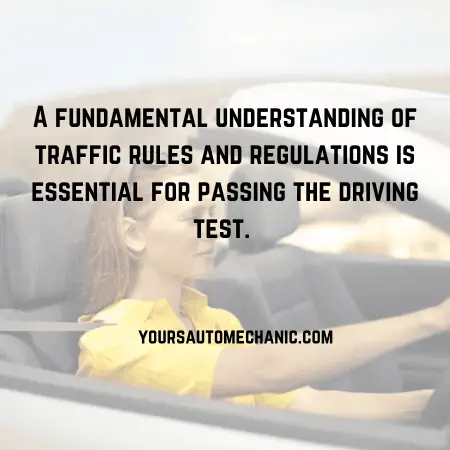Passing a driving test is a significant milestone in one’s life, symbolizing independence and freedom.
However, for many learners, the journey to obtaining a driver’s license is fraught with challenges, and failure can be a frustrating setback.
In this article, I will delve into the reasons why learners often fail their driving tests and explore strategies to improve their chances of success.

reasons: why learners fail their driving test
Driving is not just a skill; it’s a responsibility that requires competence and adherence to safety regulations. Identifying the reasons for test failure is essential for both learners and driving instructors to address underlying issues effectively. Let us explore these reasons to find out its solution.
1- Not Enough Practice:
One of the primary reasons learners fail their driving test is because they haven’t practiced enough before taking the test. Learning to drive isn’t something that can be mastered overnight. It requires time, patience, and consistent practice to become proficient.
Driving involves a complex set of skills, such as controlling the vehicle, understanding traffic signs, navigating intersections, and reacting to unexpected situations on the road. Without sufficient practice, learners may struggle to develop these skills adequately.
Practicing in various driving conditions, such as different weather conditions or traffic densities, is crucial for gaining confidence and adaptability behind the wheel. Learners who haven’t practiced enough may feel overwhelmed during the test, leading to errors or lapses in judgment.
Must Read: Is Driving Hard For Beginners? A Complete Guide
2- Nervousness:
Another common reason for failing the driving test is nervousness or anxiety. It’s entirely normal to feel nervous before and during the test, as it’s a significant milestone in one’s driving journey.
However, excessive nervousness can impair a learner’s performance. When individuals are overly anxious, they may experience physical symptoms like sweaty palms, shaky hands, or a racing heart, which can affect their ability to focus and make sound decisions while driving.
Nervous drivers may also become hyper-aware of the examiner’s presence, leading to self-consciousness and distraction. As a result, they may commit errors that they wouldn’t typically make under normal circumstances.
3- Making Mistakes:
During a driving test, examiners assess a candidate’s ability to drive safely and responsibly. While making occasional mistakes is normal, certain errors can result in an automatic failure. For instance, failing to check blind spots before changing lanes or making a turn poses a significant risk as it increases the likelihood of a collision with another vehicle or pedestrian.
Similarly, forgetting to signal intentions, such as turning or merging, compromises communication with other road users, leading to confusion and potential accidents.
Disregarding traffic signals and signs, such as not stopping at stop signs or running red lights, demonstrates a lack of awareness and respect for traffic laws, which are fundamental to safe driving.
Even minor infractions like rolling through a stop sign or exceeding the speed limit by a small margin can result in points deducted or failure if repeated frequently.
4- Not Understanding the Rules:
Understanding the rules of the road is paramount to passing the driving test and, more importantly, ensuring safe driving practices beyond obtaining a license. Traffic laws govern various aspects of driving, including right-of-way, speed limits, signaling, lane usage, and parking regulations.
Some learners may struggle to grasp certain rules due to their complexity or ambiguity. For example, nuances in right-of-way situations at intersections or the appropriate distance to maintain when following other vehicles can be challenging to interpret correctly.
Learners may forget specific rules during the test due to stress or nervousness, leading to errors in judgment or execution. Moreover, variations in traffic laws between different regions or countries can further complicate matters for learners who relocate or are unfamiliar with local regulations.
5- Not Following Instructions:
During a driving test, examiners provide instructions that candidates must follow precisely. These instructions may include tasks such as making specific maneuvers, navigating through traffic, or responding to simulated emergencies.
Failure to adhere to these instructions can lead to deductions or outright failure. For example, if an examiner instructs a candidate to make a left turn at an upcoming intersection, but the candidate turns right instead, it demonstrates a failure to comprehend and execute the given instruction accurately.
Similarly, disregarding instructions related to speed limits, lane changes, or yielding to pedestrians or other vehicles can jeopardize the safety of the examiner and other road users, thereby resulting in a failed test.

6- Lack of Confidence:
Confidence is a key determinant of driving competence, influencing a candidate’s decision-making, judgment, and overall performance during the test. Individuals who lack confidence behind the wheel may exhibit hesitancy, indecision, or anxiety-induced errors while driving, potentially compromising their ability to meet the testing criteria.
For instance, a candidate who second-guesses their lane changes or hesitates at intersections may create unsafe conditions for themselves and other road users, undermining their chances of passing the test.
Moreover, a lack of confidence may manifest as over-cautiousness or excessive reliance on the examiner’s guidance, impeding the candidate’s ability to demonstrate independent driving skills and decision-making capabilities.
You May Find Helpful
- Why All My Gauges Stopped Working While Driving & What To Do?
- Airbag Light Comes On And Off While Driving – Reasons & Solutions
- Battery Voltage Drops While Driving – Causes & What To Do
- What Happens If My Drive Shaft Breaks While Driving?
The Role of Instructors and the Learning Environment
Instructors as Guides:
Your driving instructor is like a guide on your journey to becoming a proficient driver.
They provide valuable instruction, feedback, and support as you learn the ins and outs of driving.
Their role is to teach you not just how to operate a vehicle, but also the rules of the road, safe driving practices, and defensive driving techniques.
A good instructor will tailor their teaching approach to your learning style, patiently guiding you through each step of the learning process.

Creating a Positive Learning Environment:
The learning environment where you practice driving also plays a significant role in your development as a driver.
A positive learning environment is conducive to learning, free from distractions, and supportive of your progress.
This environment can include the physical surroundings, such as quiet streets or open parking lots for practice sessions, as well as the emotional atmosphere, where you feel comfortable asking questions, making mistakes, and receiving constructive criticism.
Building Confidence:
A skilled instructor knows how to build your confidence behind the wheel.
They gradually introduce you to new skills and driving scenarios, starting with the basics and progressing to more complex maneuvers and traffic situations.
By breaking down the learning process into manageable steps and providing encouragement along the way, instructors help you gain the confidence you need to tackle challenges and overcome obstacles on the road.
Safety First:
Safety is paramount in driver education, and instructors play a vital role in instilling safe driving habits from the very beginning.
They teach you to prioritize safety at all times, emphasizing the importance of wearing seat belts, obeying speed limits, signaling properly, and maintaining a safe following distance.
Through their guidance and example, instructors help you develop a keen awareness of potential hazards and the skills to anticipate and respond to them effectively.
Continued Support and Feedback:
Learning to drive is an ongoing process, and even after you’ve passed your driving test, instructors continue to play a supportive role in your development as a driver.
They may offer advanced driving courses, refresher lessons, or guidance on specific skills or situations you encounter on the road.
Instructors provide valuable feedback on your driving performance, identifying areas for improvement and offering practical tips and strategies to help you become a safer and more confident driver.
Instructors and the learning environment are integral components of driver education, shaping your skills, confidence, and attitude toward driving.
With the guidance of a skilled instructor and a positive learning environment, you can build the knowledge, skills, and confidence you need to navigate the roads safely and responsibly.
The Psychological Aspect of Failing a Driving Test
Failing a driving test can have a significant psychological impact on individuals, affecting their confidence, self-esteem, and emotional well-being. Let’s delve into the psychological aspects of this experience:
Disappointment and Frustration: Failing a driving test can evoke feelings of disappointment and frustration. After investing time, effort, and resources into preparing for the test, not passing can be disheartening. Individuals may feel like they’ve let themselves down or disappointed others who were rooting for their success. This sense of disappointment can be compounded by the anticipation of newfound freedom and independence that comes with obtaining a driver’s license.
Self-Doubt and Insecurity: Failing a driving test can also trigger feelings of self-doubt and insecurity. Individuals may question their abilities and competence as drivers, wondering if they’ll ever be able to meet the standards required to pass the test. This self-doubt can erode their confidence and make them hesitant to try again or pursue their goal of obtaining a driver’s license.
Fear of Judgment: There may be a fear of judgment from others, such as family members, friends, or peers, upon failing a driving test. Individuals may worry about facing criticism or ridicule for not passing, leading to feelings of embarrassment or shame. This fear of judgment can create additional pressure and stress, making it harder for individuals to bounce back from the setback and try again.
Impact on Future Goals: Failing a driving test can also impact individuals’ future goals and plans. For some, obtaining a driver’s license may be a necessary step towards achieving other milestones, such as pursuing higher education, securing employment, or gaining independence. Failing the test can delay or derail these plans, leading to feelings of uncertainty about the future and frustration over setbacks.
Overcoming Setbacks: Despite the psychological challenges associated with failing a driving test, individuals need to recognize that setbacks are a natural part of the learning process. It’s okay to feel disappointed or frustrated, but it’s important not to let these emotions define your self-worth or deter you from trying again.
By acknowledging areas for improvement, seeking support from friends, family, or driving instructors, and approaching the retest with a positive mindset, individuals can overcome setbacks and ultimately succeed in obtaining their driver’s license.

Strategies for better preparation for the driving test again
Reflect on Mistakes: After failing the driving test, take some time to reflect on the mistakes you made during the exam. Identify specific areas where you struggled or where the examiner noted deficiencies. This reflection process can help you understand your weaknesses and areas for improvement.
Review Driving Skills: Once you’ve identified the areas needing improvement, focus on practicing those specific driving skills. Whether it’s parallel parking, lane changes, or navigating intersections, dedicate extra time to honing these skills during practice sessions.
Seek Additional Practice: Practice, practice, practice! The more time you spend behind the wheel, the more confident and proficient you’ll become. Consider scheduling additional practice sessions with a qualified driving instructor or a trusted family member or friend who can provide guidance and feedback.
Simulate Test Conditions: Replicate the test environment as closely as possible during practice sessions. Practice driving in different traffic conditions, on various road types, and in areas similar to where the test will take place. This will help you feel more comfortable and prepared on the day of the exam.
Focus on Confidence-Building: Work on building your confidence behind the wheel. Visualize yourself successfully completing driving maneuvers and navigating challenging situations. Positive self-talk and visualization techniques can help boost your confidence and reduce test anxiety.
Review Traffic Laws: Brush up on your knowledge of traffic laws, road signs, and driving regulations. Make sure you understand and can apply the rules of the road correctly during the test. Consider reviewing the driver’s manual or taking practice tests to reinforce your understanding.
Stay Calm and Focused: On the day of the test, prioritize staying calm and focused. Take deep breaths, relax your muscles, and visualize success. Remember that nerves are normal, but you have the skills and preparation to succeed.
Listen to Feedback: If you receive feedback from the examiner after failing the test, take it to heart. Use their comments to identify areas for improvement and adjust your practice sessions accordingly. Constructive feedback can be invaluable in helping you prepare more effectively for the retest.
Set Realistic Goals: Set realistic goals for yourself leading up to the retest. Break down your preparation into manageable steps and celebrate small victories. Setting achievable goals can help you stay motivated and focused on your ultimate objective of passing the driving test.
Stay Persistent and Positive: Finally, remember that failing the driving test is not the end of the road. Stay persistent, stay positive, and keep working towards your goal. With determination, effort, and effective preparation strategies, you can improve your skills and pass the driving test successfully.
Further Readings
- Is It Safe To Drive With ABS Light On? ( Detailed Answer )
- Can You Drive Without a Muffler? Pros & Cons Of Removing Mufflers
- Is It Safe To Drive Without Power Steering?
- Drive Start Control Malfunction – Signs & Causes
- Can You Drive With Bad Lifters? Explain In Detail
Conclusion
Failing a driving test can be a setback, but it’s also an opportunity for growth and improvement. By reflecting on mistakes, seeking additional practice, and focusing on confidence-building, learners can better prepare themselves for success in their next attempt. It’s essential to stay persistent, stay positive, and approach the retest with determination and a willingness to learn.
With dedication, effort, and effective preparation strategies, learners can overcome challenges, enhance their driving skills, and ultimately achieve success in obtaining their driver’s license. Remember, setbacks are a natural part of the learning process, and with perseverance, success is within reach.
